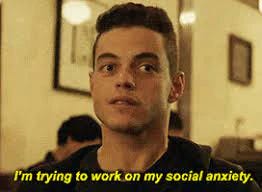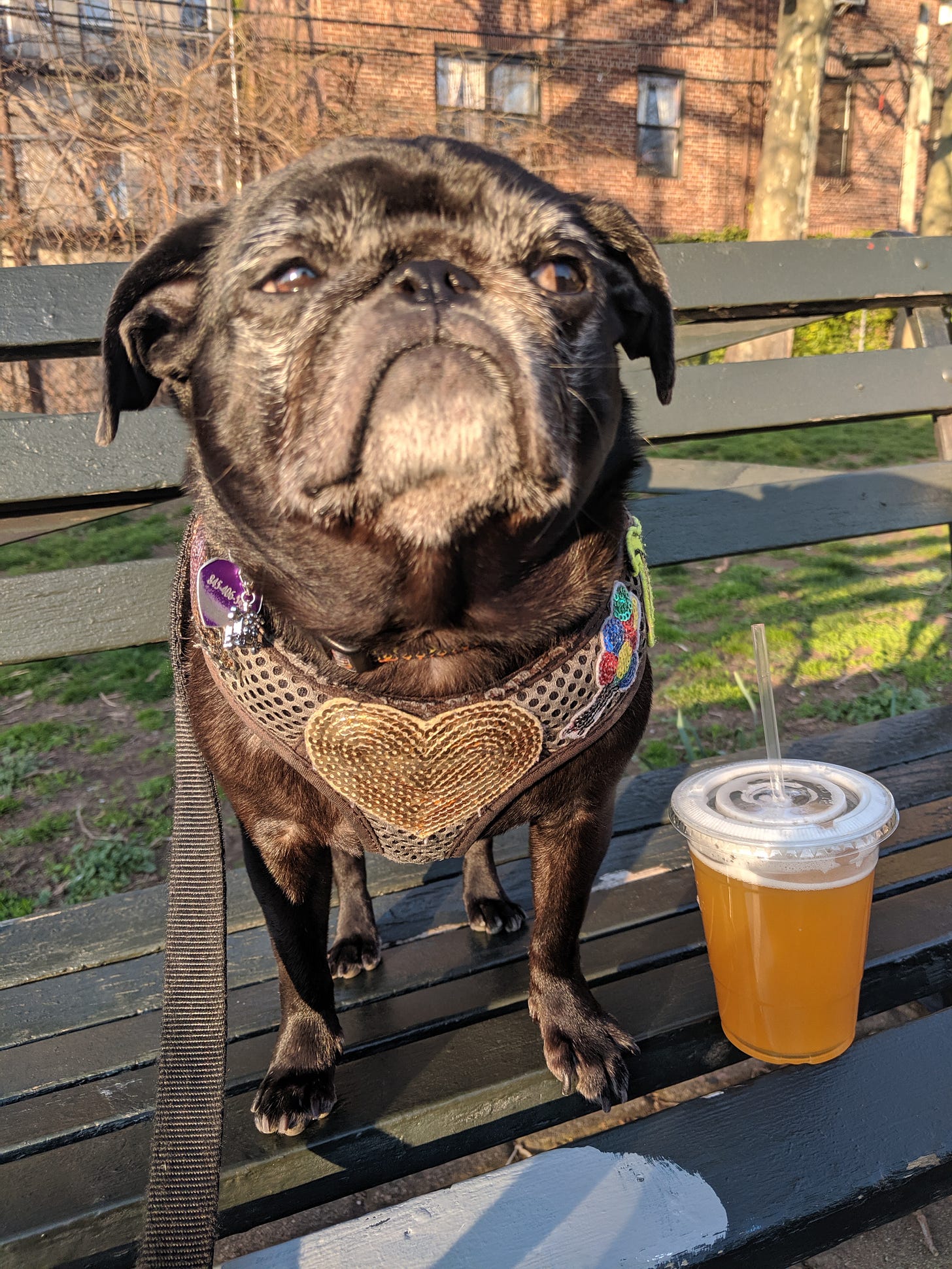43. Beer's Baby Steps Toward Real, Total Inclusivity--and the Road Ahead
The industry's got the potential, now it's got to make moves on events and spaces that are accessible for every human; plus the HTB chat with Beth Demmon, and tarot for picking your battles.
The Craft Beer Community Can Help with Things Like Anxiety, But It’s Going to Take More Than Just Good Intentions
If you’ve been reading this newsletter for a while, you’re certainly familiar with the fact that I have raging social anxiety. Two things have helped. One is, perhaps weirdly, the pandemic. I’m not trying to find silver linings in an ongoing mass trauma event. But the simple fact is that the way we’ve had to live over the past two-plus years has made people so much more candid about their mental health and, specifically, social anxiety. When re-emerging into the world, everyone was talking about how they forgot how to converse and socialize, and how awkward they felt. It’s not like it felt good to see other people suffering with anxiety, but it flipped my internal script. I realized I no longer felt the need to pretend I had it together. No one has it together. The more we talk about our anxieties and all of our mental and emotional struggles, the more we can be kind to each other. The more we can each feel understood. The more welcome we feel in a space. And all of that can lead, of course, to an actual lessening of some anxieties in some cases.
The second thing is the beer industry. For all the problems this industry has, I think it’s reasonable to still say that somewhere in there remains a nice community aspect, and it’s exactly that that motivates many of us to even stick around and fight for better conditions. We can all rattle off the names of assholes—and worse—in beer, I’m sure, but then each of us can also tick off maybe even more names of people we consider industry or community friends, who maybe have even become just regular life friends. I have forged connections the likes of which I never even thought possible when I worked in fashion.
Over the past few years, the simple practice of continuing to walk into events and have not just an easier time than I anticipated having chats with people, but an actually pleasant time, has helped whittle away at my social anxiety. Being able to belong to groups like the Pink Boots Society has helped. Keeping in touch with folks on social media, blight on humanity that it is, has helped. The anxiety is definitely never gone—for some reason, it’s crippling on Zoom?—but it’s better. It was such a nice surprise, for example, to spend most of the NYC Beer Week Opening Bash chatting, and to leave feeling invigorated by that instead of exhausted. That’s a version of myself I wouldn’t have recognized even a couple of years ago. Currently, I have less anxiety heading into a beer event than I do going to, say, the party of a friend where I don’t know their other friends too well.
Beyond the inherent communal nature of craft beer, and because of it, it’s an industry well-poised to actually, actively address things like social anxiety; other kinds of anxieties; neurodiverse disorders and conditions; mental and emotional differences; physical disabilities; and more. Beer’s spaces and events are hubs for socializing and for solo experiences, they’re time-honored third places that can be positive influences on our lives if they’re designed with care, and so much of this industry is still ever growing so there are so many new places and events that can be designed more inclusively from the ground up.
I recognize I’m speaking from a place of extreme privilege that social anxiety is the only barrier between me and a “normal” (read: pleasant, approachable, without stresses and challenges) experience. (I hesitate to say “safe” because that for women, BIPOC, queer individuals, and all underrepresented groups, speaks to an entirely different aspect of experiencing craft beer culture, which we discuss here often). But the way the beer industry has potential to and has already started working toward greater accessibility for all, and the way that many of us are becoming increasingly open about our struggles and our needs—it all has me thinking a lot lately about the myriad ways we interact with our surroundings and what a much more inclusive future in that regard could look like.
The most recent catalyst for thinking about all of this, for me, was David Nilsen’s piece “It’s Okay That You’re Not Okay | Coping with Anxiety in Craft Beer” for Porch Drinking. I love this piece and all of its elements—its vulnerability and candor, its enlightening reporting, its comprehensive inclusion of insights from those with anxiety in craft beer. Here, you can see collected in one place how some of American craft beer’s very foundation is built on environments that feel anything but welcoming to all people. Giant, open taprooms with nary a corner to tuck into, and long, communal tables. Crowded festivals where everything seems to hinge on your willingness to be constantly conversing with strangers. I would add to this any kind of free-form “networking” (or similar) event where there is no theme or shared activity in the course of the evening—asking me to just show up and exist in a room hoping I can find another human being to organically start talking to is a lot.
These designs that really define craft beer really embrace the whole community thing, but they don’t do so inclusively. We can foster community without forcing everyone to remain completely vulnerable in a sea of strangers, we’d much better foster community by taking way more differing needs into consideration. It’s like, I see your intentions, Craft Beer Industry, but let’s take that community focus and turn it into something inclusive, accessible, and welcoming for all. What does that mean? Lots. There are lots of things those in the position of designing spaces and planning events can do. One that immediately pops to mind is safe spaces. We’ve talked about these for festivals, but why not permanent ones at taprooms, too? Sure, have the big space with communal tables, but maybe there could be nook-ier spots for, say, folks who would like to spend their entire visit with no one other than their book. Think about where the restrooms are, and how clearly they’re marked, so no one has to navigate a gnarly crowd or keep asking people where they need to go.
Clear communication, in general, is fucking key. I’m talking to you, breweries: what the hell is going on with so many of your websites and social media profiles? If you’re a nomadic brewer without a taproom trying to cultivate some kind of mysterious identity—I mean, lol, but whatever, your call. But if you have a physical space intended for other humans to come visit, we’ve got to have some basic information.
I see your hours, thanks. But…Why is it one of the planet’s best-guarded secrets whether you allow dogs (especially since apparently, emotional support dogs aren’t considered a “thing” anymore even though many of us very much need ours)? What’s your restroom situation like and don’t you think you’d make a lot more people feel comfortable heading in for the first time if they knew if they were gender-neutral facilities? Are you wheelchair-accessible? No, really, because those three steps going in count, and so does the hallway to the bathrooms that you’re using more than half the width of to stack kegs. Do you have a weird ordering process (or will you quite literally scold me for placing my empty glass back on the bar instead of the completely unmarked barrel I was supposed to know was designated for such when I just thought I was being helpful bussing our table, Suarez Family Brewery?) Because if people have to stand on one line to pay and another line to receive a token and a third line to trade it in for a beer only after solving three riddles and doing the hokey-pokey in reverse, it might make those of us with anxiety more comfortable to know that ahead of time.
Breweries were a great option for my family to get together on weekends because restaurants and bars were a total crap shoot, one that often didn’t go in our favor, when it came to my mom’s wheelchair. I’m torn there, because I get it. Buildings in New York are so old and so tight, frankly, yeah, I don’t really know what most places can do. It sucks, and it’s not fair, and I don’t know what the solution is. Breweries, on the other hand, typically have a lot more space to work with. Nine times out of 10, we knew we could head to a brewery, get in without steps, and have plenty of space (again, always helpful to get that info ahead of time online). The sheer size of many taprooms is a huge leg up for breweries, one of the reasons that, again, craft beer is a well positioned industry for inclusive advances. There’s a lot to work with when thinking about design.
As David’s Porch Drinking piece points out, realizations about what makes a welcoming space often don’t present themselves until we’re actually in one and truly process what’s different. It’s something I realized at Twelve Percent Beer Project in Connecticut. The taproom—raised but wheelchair-accessible via a ramp—is done in calming, lovely neutrals, designed to be much comfier than your typical industrial taproom. It’s open and spacious, yet there are still plenty of cozy corners to tuck into if you don’t actually want to be in that openness. This is something I’ve started being really conscious of as I visit more breweries for the first time, especially since it’s becoming increasingly de rigueur for breweries to focus more on taproom design and really craft an experience.
Encouragingly, some breweries are even actively thinking about things like neurodiversity as part of that design, too. For Good Beer Hunting in February, Beth Demmon wrote about this need and how Colorado’s Brewability Lab and Pennsylvania’s Perkiomen Valley Brewery, in particular, are addressing it. And other breweries, too, are making purposeful steps toward including everyone in their space beyond design. Eugenia Brown posted about braille menus at NoDa Brewing—how great is that? It makes you suddenly stop and wonder, why not braille menus everywhere? I wonder how big of an investment something like that would actually be, especially when the payoff is that you are welcoming and accommodating an entire group that maybe did not feel so before.
I think the tools—beer’s community focus, breweries’ place in our lives—as well as the beginnings—these breweries starting to lead the way—are there. We’re having these conversations much more than we were five, three, even two years ago, and that’s the biggest hurdle as well as the biggest motivation. But I also think we need a lot more progress, a lot faster. And of the obstacles that stand in the way of that, just stopping to think about someone other than one’s self seems like one of the biggest but also one of the easiest to overcome. See, the way I feel when I’m overwhelmed in a space or at an event, is that it was concocted by someone who doesn’t struggle with any sort of anxiety or condition or disability—and didn’t take a second to think about what it would be like if they did.
Take, for example, this Twitter conversation about beer festivals. Bringing up Beth Demmon again here—she basically tweeted about how cool it would be if there was a beer festival where you could just jam out to your own music in your own headphones and live your damned life enjoying the beer around you.

This idea was mostly met with supportive tweets expressing how much fun this kind of event would indeed be. But I noticed something about the kinds of responses that were like “What? Boo, that’s not the point of a festival!” there and on Instagram. They were from men. This is like the reading-in-bars Twitter debacle. These comments are made by dudes who don’t take a nanosecond before gifting the atmosphere with their honking mouth noises to think, “Maybe my experience is not everyone else’s experience.” No, maybe you, @AlwaysBeHustlin or whoever tf, have never experienced what it’s like to be harassed at a bar or a beer festival. And maybe you have never struggled with social anxiety, or simply feeling overwhelmed and wanting to be able to enjoy something you like quietly.
In what I presume is usually a much more innocuous way, I do think this simple oversight is at the heart of how much accessibility is missing in craft beer. The people designing spaces and planning events just aren’t thinking about it. But we’re talking about it all now, right? So, there’s no excuse anymore. Think about this stuff. We’re in an industry where we can really set an example here, and make a lot of people feel welcome for once in the process.
Listen to the Hugging the Bar Chat with Beth Demmon!
Last week, I published a partial transcript of the second Hugging the Bar podcast episode, with Beth Demmon. The episode was available on Patreon (why not sign up for that kind of VIP access?). This week—drum roll, please—I’m pleased to share the public link. It’s easy to listen to this in the podcast app of your choosing, too, just click the link that says “Listen in podcast app.” Okay, you crazy kids, here’s the episode. Enjoy!
Beer Tarot!
This week, I pulled the Five of Swords.

Swords speaks to intellect and decisions, and the Five of Swords specifically speaks to conflict, defeat, competition, and the will to win at any—even nefarious—cost.
This card comes up if either you’re currently competing for something and it’s taking a toll on you, or if you’ve recently had a conflict and still don’t feel good about the outcome—whether you “won” or “lost.” Like, maybe you technically won an argument or some sort of fight for something, but perhaps you don’t love the way you went about it or the whole process made you lose trust in someone or something, or even yourself. Or, maybe you lost and the impact of that is rough, whether it’s personal or professional or both.
The overall concern of this card is that you do damage control. For starters, it wants you to pick your battles. This feels very relevant these days, when everything is a fight and a struggle. Really think about what matters to you and what is actually impactful before you engage. (It’s shocking how much energy we lose on Twitter, you know?) And if you are in a post-conflict stage and are upset in some way, why—what can you do about it? Apologies to be made, olive branches to be extended, or maybe even toxic relationships finally truly ended? There’s plenty to compete over right now, and plenty to fight over, so be prepared to do both. But the only way you’ll do so impactfully and meaningfully is if you don’t get swept up into every single fray.
For this tarot card, drink Hackensack Brewing’s Politics & Religion coconut DIPA—because those are the things you know you’re going to have the most draining battles over. So, treat yourself?
This Week’s Boozy Media Rec
I feel like I’m forever playing catch-up with articles and podcasts alike lately. But if you haven’t yet listened to Dave Infante’s interview with writer and podcaster Rax King for the Fingers newsletter + podcast, I highly recommend it. It manages to feel both like you’re getting some good industry insight but also like you’re taking a much-needed fucking break and just listening to a fun conversation. Rax hosts the Low Culture Boil podcast and wrote Tacky: Love Letters to the Worst Culture We Have to Offer, which features everyone’s favorite Guy Fieri-centered essay, so you can count on both Fieri as well as Creed talk—if that doesn’t entice you, idk what will. The episode is for paid subscribers only, but that’s an investment in content you won’t regret.
Ex-BEER-ience of the Week
I did not drink a lot of beer last week, because I was getting over food poisoning and figuring out how to survive a really busy week on a diet of saltines and ginger ale. I did have a delicious American IPA at Newark Local Beer before watching Judas Priest at the Prudential Center; both were rad experiences. And on Sunday, I had a pretty perfect lager, Sixth Man, at Other Half’s Rockefeller Center taproom after taking in a Hans Holbein exhibit at the Morgan Library—pondering some Dance of Death over a good lager is as good an ex-beer-ience as any, I’d say!
Until next week, here is another early-pandemic Darby with…a beer with a straw? Idk, she looks very skeptical about it, as well.






